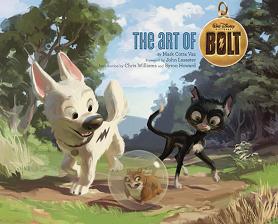Each animator is an artist in his or her own right, with a unique personality and background that they bring to the character they’re working on. The richer the experience, the greater the animation. In animation and art, Cinzia Angelini’s experience is a model of versatility and richness. Working in the field of animation for the last fifteen years, she participated in many major productions involving traditional as well as computer animation.
Born in Milan, Italy in 1971, Cinzia pursued her vocational training at the College of Arts and Sciences of Milan. She attended the Centro Formazione Professionale per la Tecnica Cinetelevisiva or C.F.P, after which she began working as storyboard artist and animator for TV shorts at several Italian studios. Among them were Mixfilm, Animandus, La Lanterna Magica and Animation Studio. Cinzia created a series of individually painted guitars that won critical acclaim, and were then featured in various Italian fashion magazines. In 1994, she moved to London and worked on the film Balto, at Steven Spielberg’s Amblimation Studio. Later in Munich, Cinzia worked as animator for Munich Animation Studio, where she contributed to the production of The Fearless Four.
Drawn back to London in ’96, she joined Warner Brothers as animator for The Quest for Camelot. Eventually Cinzia was brought to Los Angeles by DreamWorks, where she worked as animator under the supervision of James Baxter on films including The Prince of Egypt, The Road to Eldorado, Spirit: Stallion Of The Cimarron and then Sinbad: Legend Of The Seven Seas. She joined Sony Imageworks in 2002, completed Spider-Man 2 (“Best Visual Effects” Oscar Winner, 2004), Open Season and guest-lectured at universities in Hawaii. Then she got to work at Disney Animation Studios as Supervising Animator on Toy Story 3, Meet the Robinsons and most recently Bolt.
Presently living in Los Angeles with her husband William and their daughter, at the same time Cinzia continues to develop her personal projects, such as the current “Italy around the corner” – a collection of her original works featuring Italian landscapes. She pursues her artistic interest painting in oil on canvas and in acrylic on mahogany. Cinzia’s works have been shown at several international exhibitions, and, most recently, the Enisen Gallery of Glendale featured works from her project “Italy around the Corner.” She’s also preparing new projects in animation such as the promising Antique Shop.
Very much attached to quality animation, she praises Bolt as the return of the highest level example of this at the House of Mouse.
 Animated Views: You went from Milan to London and from London to LA. Can you tell me about that extraordinary adventure?
Animated Views: You went from Milan to London and from London to LA. Can you tell me about that extraordinary adventure?
Cinzia Angelini: After working in Milan, Italy for about a year I had the chance to work at Amblimation for the completion of Balto. That was a wonderful opportunity to work in such a creative environment, with so many talented people. I had lots of fun and learned a lot. It was like being released from a cage and sent into the Amazon Jungle! After that I spent a year in Munich working for Munich Animation, where I started animating, and then went back to London to work at Warner Brothers Animation. Then in 1996, DreamWorks invited me to join them as an animator on Prince of Egypt. I was finally moving to L.A.
AV: Italy remains very present in your work, especially in your painting. Can you tell me about the importance of your country in your artistic personality?
CA: That’s absolutely right. Following a few years of traditional animation I really felt like I needed to concentrate on something that would stimulate my creativity in a different way. Since my mother is a painter herself, painting came naturally. Colors and canvas were very familiar to me growing up. The desire to paint Italian scenes arose from being here for a few years. I missed those places and was moved to create “Italy around the corner”, a project of mostly acrylic on mahogany, painting “around the corner” or edges of the wood canvas. I haven’t painted for a while now but hope to get return to that soon.

AV: Can you explain your fascination for the guitar?
CA: Music and instruments have always been a part of my life. At the time, I was studying guitar and one day just started creating a design for one of my instruments. It became a part-time job for me as I pursued my studies. I sold many of them to shops and private collectors in Milan. In the early nineties, my painted guitars where featured mostly in Fashion shoots for Italian Magazines. It was fun to do and, as I finished art and animation schools, allowed me a taste of the business world.
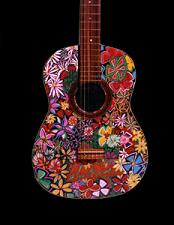
AV: At DreamWorks, you worked under the supervision of James Baxter (Enchanted). Can you tell me about how it was, working with such a legendary artist?
CA: The DreamWorks experience was fabulous! Not only did I have the thrill of joining such a great studio, but also the chance to work with an amazing animator like James. He has always been extremely respectful of everyone’s work, and crews really admire him in turn. Whatever work I brought to him he gave positive feed back on, and treated my scribbles with encouragement – as if they where going somewhere. I learned how to plan a scene, how to think about the characters I was animating, about spacing and poses. At the studio we all used to say, “there is James, then nothing, and then the rest of us.” His gift as an animator is that he can balance performance and technique to perfection.
I would love to work with him again in the future. It’s really not enough to be just a brilliant animator. Supervising other animators to successfully produce the overall project takes a special skill. Luckily for us, James embodies all of that. He is able to bring his artistic gift and managerial talent together in such a way that has us all awestruck. There is an intense loyalty and work ethic that comes from such leadership, and enormous respect all the way around. It really doesn’t get much better than that when working on a film.
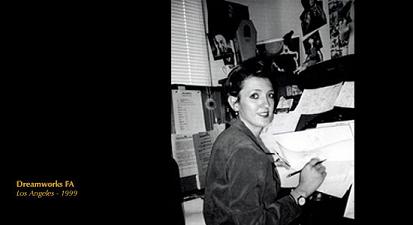
AV: Can you tell me about the different characters you animated at DreamWorks?
CA: When I first joined DreamWorks I worked for a few months on Prince of Egypt, as they finished up animation. It was great and at the same time, very challenging. It was the first time I had animated a realistic human being – Moses. I was very fortunate to work with the supervising animator for Moses, Christophe Serrand.
 The next project, Eldorado, had a broader animation style. I ended up on James’ team, animating on Tulio, and then Spirit. Before beginning Spirit, we underwent a long training program to prepare us for drawing and moving horses around. Horses are one of the most challenging animals to animate. I learned a lot on that movie, especially because it involved lots of research and preparation. It wasn’t easy, but certainly rewarding by the time it was finished.
The next project, Eldorado, had a broader animation style. I ended up on James’ team, animating on Tulio, and then Spirit. Before beginning Spirit, we underwent a long training program to prepare us for drawing and moving horses around. Horses are one of the most challenging animals to animate. I learned a lot on that movie, especially because it involved lots of research and preparation. It wasn’t easy, but certainly rewarding by the time it was finished.
AV: It is at DreamWorks that you began to work in CG. How was that?
CA: Ever since the release of Toy Story, I’ve been very attracted to CG animation. When DreamWorks decided to give it a try and see how traditional animators would take to animating with a computer, I was first on the list! I believe they picked eight people at the beginning of Spirit. Luckily for me, I was given two months training and the opportunity on Spirit to animate both traditionally and CG. For the movie that followed, Sinbad, I used mostly CG on the Sirens and Roc.
AV: How did you come to Sony Imageworks, from feature animation to VFX animation?
CA: After four films with DreamWorks, I was ready to move on and try something different. While it was a difficult decision, I decided to give the world of VFX a try. I always dreamed of working for DreamWorks, and so was very torn. At the same time, I really needed to see what was out there and had an opportunity presented to me. Imageworks brought me on board to work on Spider-Man 2. Working with Anthony LaMolinara, the animation director for the project was really fun. He was always very protective of his animators, and instilled that all-important teamwork that resulted in an Oscar.

AV: To you, what are the differences between VFX animation and feature animation?
CA: Now that I have worked on both feature animation and Visual Effects I can say that in terms of the work involved, there isn’t much difference between the two. Of course it depends on the project and the people you work with. It’s fun to work on both realms. It keeps you from getting bored and stimulates creativity more. I find myself drawing from and combining the experience and tricks I learned from both worlds. Perhaps just knowing one can do both makes one feel more complete as an animator.
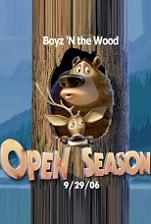 AV: Then you went back to feature animation, in CG, with Open Season. How do you approach CG animation regarding hand-drawn animation ?
AV: Then you went back to feature animation, in CG, with Open Season. How do you approach CG animation regarding hand-drawn animation ?
CA: After Spider-Man 2 I was one of the first animators to move on Open Season. I spent a few months just testing the characters, working side by side with the riggers. It was something I had never done to that extent before. I believe the main difference between hand drawn animation and CG is that with traditional animation, the animator is pretty much in control of everything. The end result would be only of her making. In CG, the animator’s abilities depend and rely upon the quality of the rigs. Fortunately, rigs are getting better and better, and animators can work with faster and more sophisticated and flexible types. Most of the time, when animating in CG, I feel that my hands are tied. It can subsequently be difficult to achieve what I have in mind. Thankfully, the technology behind the rigs is improving with every film. Soon the artists will have even more control and the visual possibilities will truly be endless.
As far as method goes, I don’t see any real difference. I tend not to thumbnail unless it’s a very complicated shot. I usually just internalize what the character has to do and plan accordingly. I think that animating with CG is easier because you don’t have to deal with keeping the character in model. But it can also be less rewarding personally. It’s more of a group effort to bring a shot to completion than with traditional animation.
AV: You began at Disney with their version of Toy Story 3 at Circle 7 Animation. What was that whole experience like?
CA: I was offered the opportunity to be a supervising animator for Toy Story 3 working at Circle 7 in Burbank. The studio was extremely nice and I liked it right away. I felt ready to move up and start supervising, and since it can be very difficult for a woman to get such opportunity, I didn’t want to miss that.

I accepted and looked forward to following Anthony LaMolinara (Spider-Man 2) who was to be the animation director for that project. Then Disney announced the Disney-Pixar merger the same day I joined. What happened next is history. I moved into the Feature Animation building and started work on Meet the Robinsons.
AV: So, you’ve worked for Warner, Amblin, DreamWorks, Sony and Disney. What would be the differences between those different studios?
 CA: With the introduction of CG animation, and a host of other enormous shifts and changes in the industry, it’s impossible to summarily make some broad statement that would do justice to the influence each studio has had on my work. What I can tell you briefly is that I hold a special fondness for Amblimation. It was the first studio I worked for abroad, and I have great memories of my time there. It was the starting point for some of the greatest animators of our time, and I felt very honored to be part of that company. It has since grown into DreamWorks, but the original Amblimation philosophy survived to create one of the most stable animation studios today. Kung Fu Panda is a great example of just how far DreamWorks has come in just a decade. I loved that film.
CA: With the introduction of CG animation, and a host of other enormous shifts and changes in the industry, it’s impossible to summarily make some broad statement that would do justice to the influence each studio has had on my work. What I can tell you briefly is that I hold a special fondness for Amblimation. It was the first studio I worked for abroad, and I have great memories of my time there. It was the starting point for some of the greatest animators of our time, and I felt very honored to be part of that company. It has since grown into DreamWorks, but the original Amblimation philosophy survived to create one of the most stable animation studios today. Kung Fu Panda is a great example of just how far DreamWorks has come in just a decade. I loved that film.
Sony too has broken new ground, though being known as a VFX studio apparently doesn’t garner the same respect from animators as the other studios. One of the pitfalls of the visual effect world is that the animator is not regarded as highly as one working for the feature animation studios.
Disney of course was once the standard bearer of Animation. I would have loved to have been at Disney in the Golden Era of Animation. To my surprise, Disney has faced many challenges and had to make difficult choices, including laying off massive numbers at their studios. Whenever that happens, for whatever the reason, it has a horrible effect on morale. I only hope that the studio regains its footing soon and is able to benefit more substantially from its merger with Pixar.
The Pixar philosophy is sound, even brilliant. But my experience at Disney taught me that implementing that philosophy comes at a cost, and can be met with severe resistance in certain circles. Still, the world of animation is small, and things can shift and change dramatically. Perhaps in time, Pixar will manage to restructure the Disney Studio to emulate its more progressive approach more successfully. It could only benefit the studio, and the industry as a whole. I have to believe the people at Pixar understand this.
AV: You took part in one of Robert McKee’s famous seminars. What is the importance of story in your animation?
CA: I have always been fascinated by the story process, and focused on improving on that these last few years. I loved Robert McKee’s class and I also took many classes with Bruce Block, and others. Knowing the story process is fundamental; a single shot can be a story all its own. The more you can know about the overall process of producing and realizing a movie, the better.
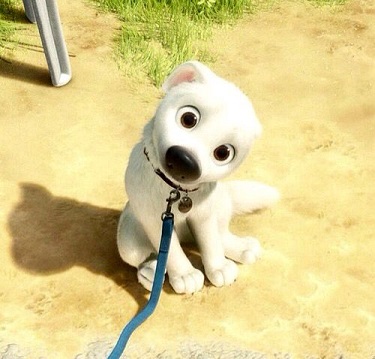
AV: How did you come to Bolt?
CA: After Meet the Robinsons, the animators had an extensive training program to prepare for the animation on Bolt. Chris Williams and Byron Howard were busy putting together a story in record time. Once the animation started we were all in the same boat, and had to catch up. Consider that the release date wasn’t going to move even if Bolt had become a completely new movie from American Dog. The story was new, new designs, new models, and new rigs. I think the only thing that was carried over was the amazing art direction of Paul Felix.
AV: It is said that John Lasseter was very much involved in the production of the film. How did that work?
CA: John Lasseter spent most of his time with the directors, shaping up the story. And having seen the result, they’ve done an amazing job. At the beginning of animation John spent some time with the animators reviewing behavior tests and giving us his ideas of who the characters were. He let us know what he was looking for and what he wanted to avoid. It was interesting to witness his approach to the overall process. Byron Howard took over animation and was the director that the animators dealt with, as far as approval of shots and so on. Byron is a very talented story artist and animator and was able to judge the shots from both those perspectives.
AV: What was your assignment as an animator on Bolt?
CA: I actually animated all the main characters, Bolt, Mittens, Rhino and Penny, in different sequences. One of the sequences I worked on is at the beginning of the train scene when Mittens, just before Bolt jumps down the bridge, figures out that Bolt is a Television Show hero.
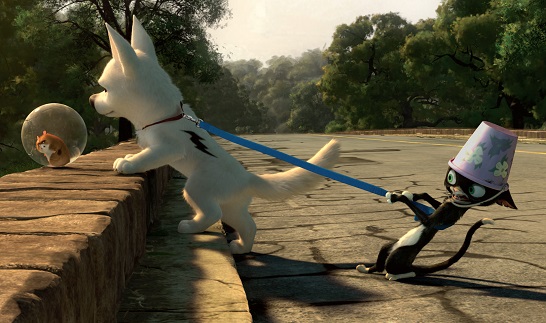
AV: What kind of challenges did you face?
CA: Our biggest challenge on Bolt was the crazy schedule. The studio was very fortunate to have such an amazing group of animators who were able to deliver outstanding animation under such incredible pressure. That said, one of the biggest challenges for me was to animate shots when Bolt and Mittens are connected by the leash. That was a constant connection that had to remain between the two characters. It was both an artistic and technical challenge for all departments. When the story department first introduced that idea, we all choked because we knew what was coming our way. But the end result was worth the pain. It’s funny and very entertaining.
AV: What scene did you enjoy the most doing?
CA: That would be the train scene I mentioned earlier. Mittens pulls on the leash that is tied to her waist, turns around and stands up on her back legs, pulling with her front in a more human way. The Mittens rig was never meant to act as a biped, so that movement required lots of cheats and compromises. But it certainly paid off.
AV: Did the strong visual style created by art director Paul Felix have any influence on the way of animating the characters?
CA: I wouldn’t say that the visual style influenced the animation, but the quality of animation has definitely stepped up for Disney Animation Studios compared to the animation of the previous years.
AV: Indeed, the animation is…awesome!
CA: Disney Animation is finally going back to the quality of animation that it was always known for. This is thanks to the positive, direct influence of Pixar.
Bolt was a very challenging movie to work on. The animation had to be entertaining and believable at the same time. The characters were stylized but needed to move very dynamically. The pace alternated between a “super hero” type of move to a very sentimental and internalized performance. Being able to work on both and pull all of those requirements together for the final product was very fulfilling. At the end of the day, I think everyone can be very proud of this film. After so much effort on the part of every department, and every individual, it’s extremely satisfying to end up with something so entertaining. As we all know, despite every effort of a production, that doesn’t always happen. I think Bolt is a winner.
On the other hand, it’s unfortunate that more than half of the animation crew was let go as soon as Bolt animation was finished. As I mentioned earlier, once the dust settles and Bolt is released, I hope Disney will be able to re-introduce some stability at the studio. Bolt required great effort on all levels, and is a movie that deserves to be seen. I believe it will be very successful.
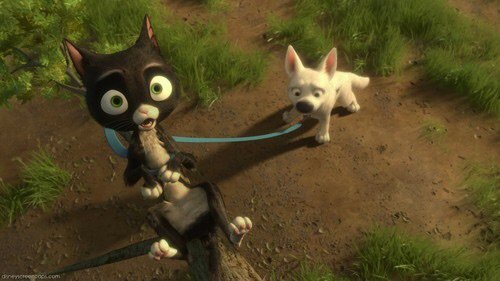
AV: What are you working on now?
CA: For the past few months now I’ve been at Warner Bros, where they are producing five computer animated shorts for PEPFAR (President’s Emergency Plan for AIDS Relief), a government project. The director is Chris Bailey, the producers are Andrew Egiziano and Aaron Parry (Main Street Pictures). It’s a very quick and intense project that might lead to the production of a feature for 2009. It feels rewarding to be able to participate in a cause as important as the fight against HIV. That opportunity doesn’t come along every day. The hope is that this might indicate a new beginning for a Warner Bros Animation Studio – this time based in computer animation. The animation industry keeps hoping that Warner will return to producing high quality features, such as The Iron Giant (1999) for example, one of my favorite films.
AV: Among your personal projects is Antique Shop which you would direct. A natural evolution for you?
CA: I love animating interesting characters and shots, and I always will, but, yes, assuming the role of Director does feel like a natural “next step” for me. However, I wanted to challenge myself by taking on a project that I knew I would be able to complete – a short film is the perfect way to work through the challenges of a feature, but on a much more reasonable scale. I am very excited by this project and constantly inspired by the team that has contributed so much to it’s development.
Antique Shop (working title) is my personal passion project, inspired by the true story of my mother’s experiences as a very young girl in Italy during World War II. We started it as an after hours “club” project with a lot of our co-workers at Disney. We created a very healthy environment of respect and trust for the entire team and had over 100 people that signed up to work on it in their spare time, taking it on as their own passion project. We did some great things with it, but unfortunately the timing was not right for it to continue moving forward there.
Thankfully I was able to secure the rights to Antique Shop before leaving Disney. While I can’t go into details, we’re exploring avenues to develop the project further at other studios. I now have the rights to the project and will continue to push this forward as an independent short film. In collaboration with my Producer, Virginia Perry Smith, and many of the artists from our original team, we are currently seeking funding and developing exciting new production models that will allow us to take this amazing project through to completion. We look forward to sharing it with you…
AV: It’ll be our pleasure to follow you in your upcoming and promising ventures!
With all our appreciation to Cinzia for her time and kind help.
Photos and paintings by Cinzia Angelini. All rights reserved. Used by permission. Bolt pictures ©Disney.


